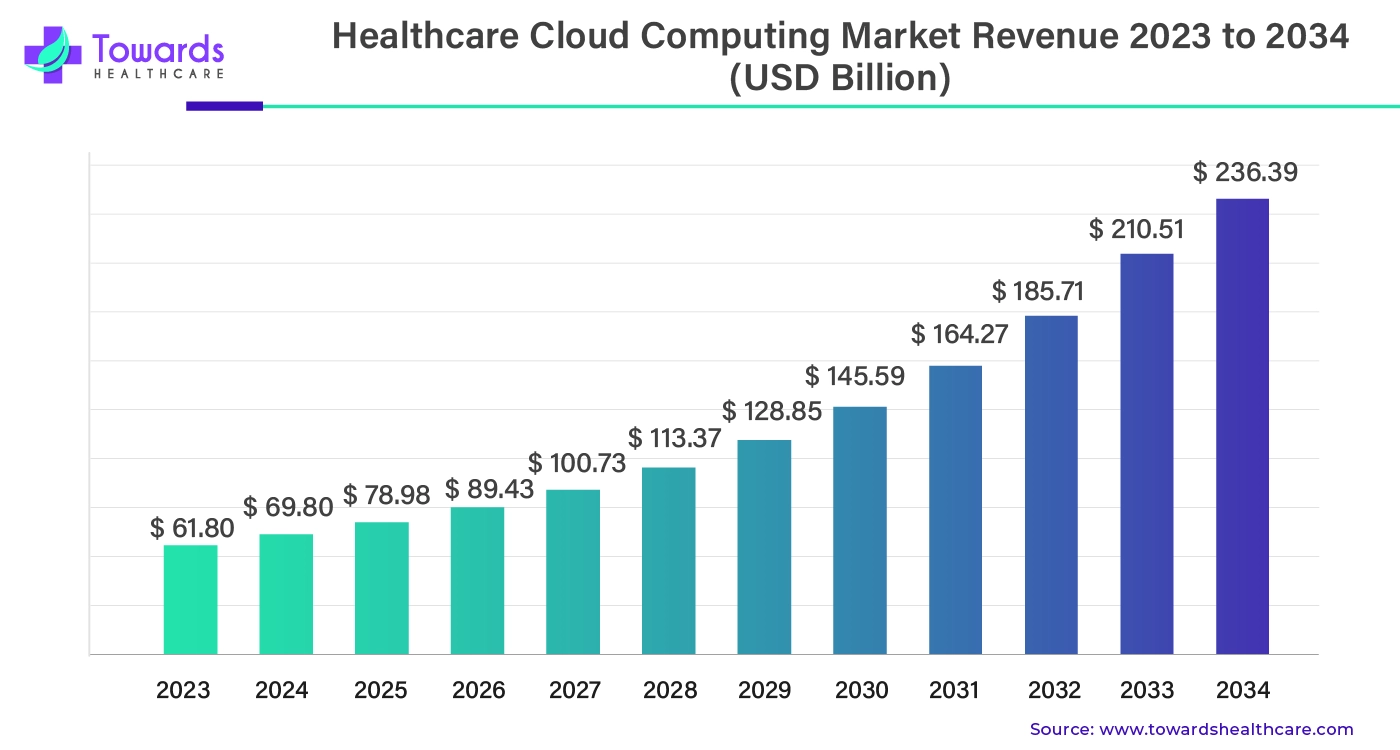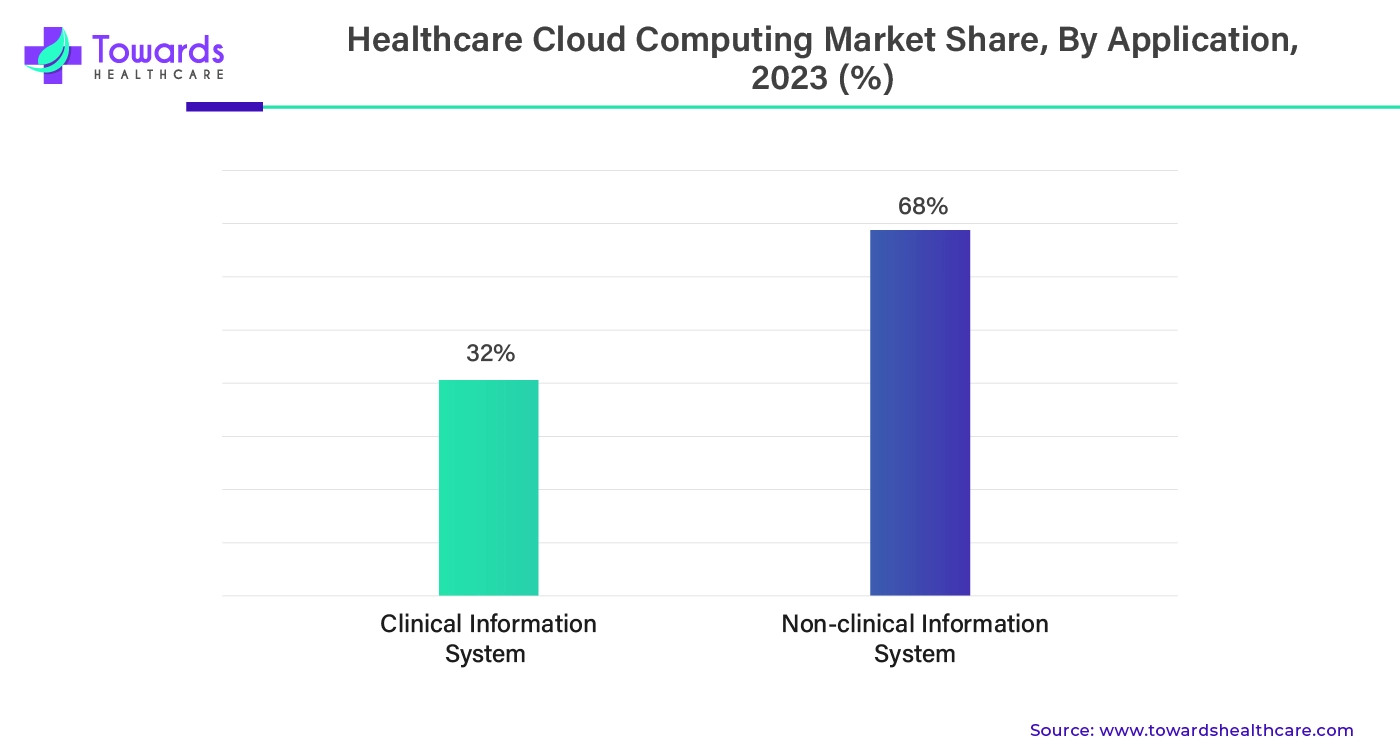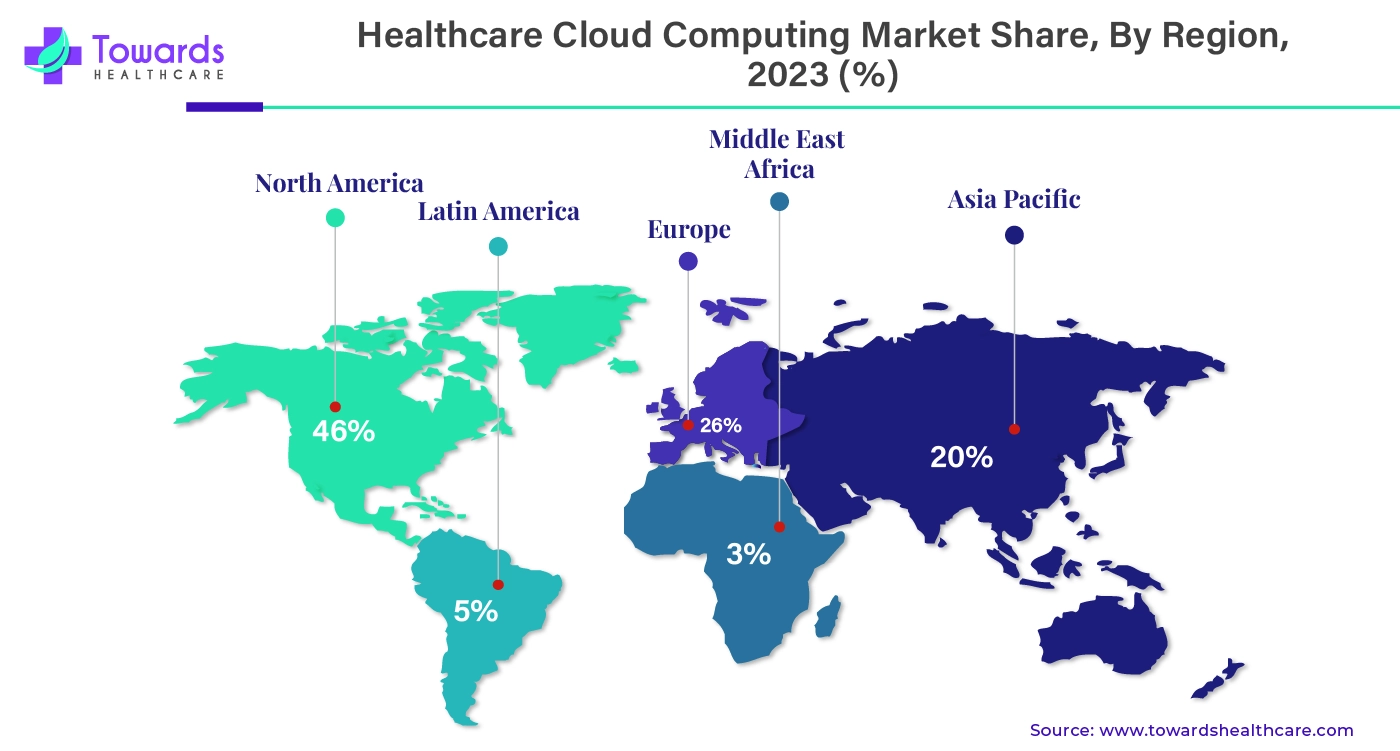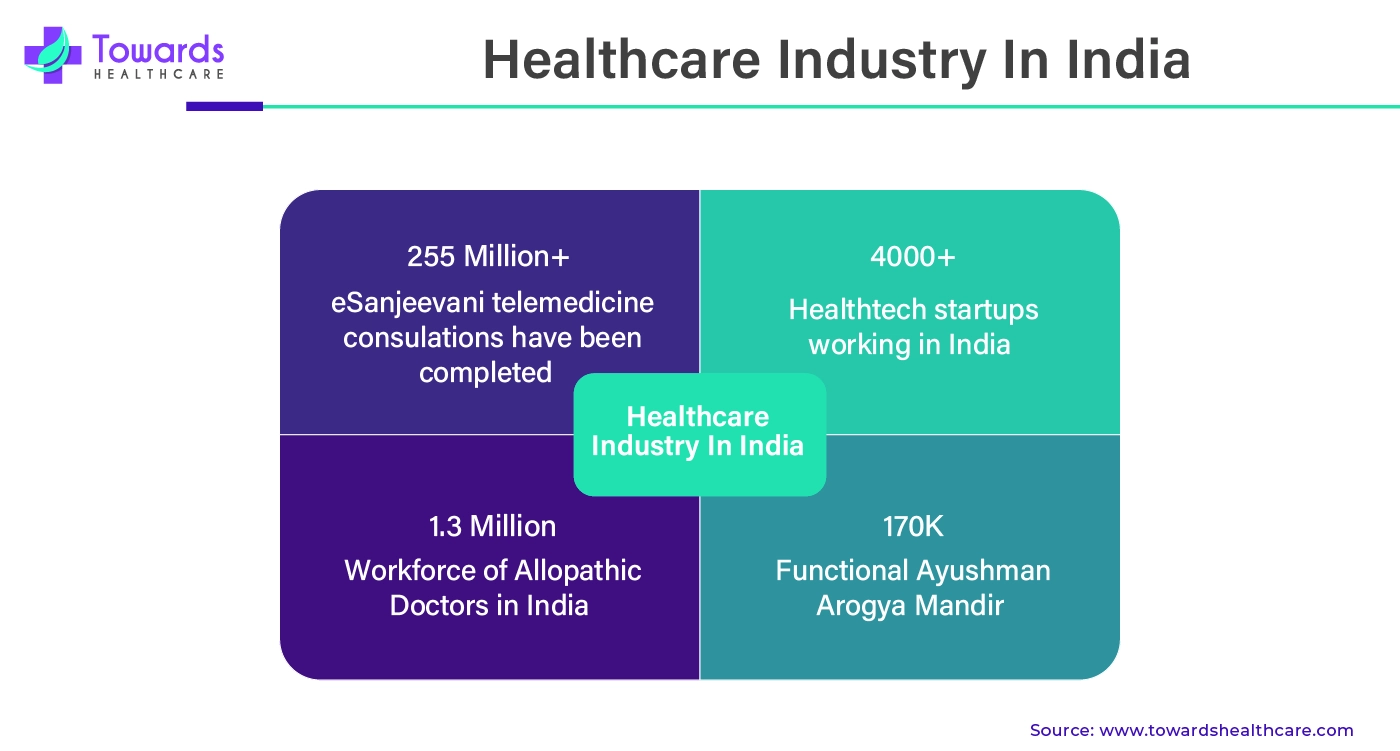March 2025


Principal Consultant

Reviewed By
The global healthcare cloud computing market size was estimated at US$ 61.80 billion in 2023 and is projected to grow to US$ 236.39 billion by 2034, rising at a compound annual growth rate (CAGR) of 13.05% from 2024 to 2034. Storing and using data on personal devices can slow down the systems, which becomes a very big issue when providing healthcare. Therefore, cloud computing has become a necessary tool for the smooth flow of various operations that are conducted in the healthcare sector.

Various services provided over the internet with the help of computing resources come under cloud computing. The cloud computing resources include infrastructure, storage, software, tools, etc. The healthcare cloud computing market provides these resources to the healthcare industry for various operations. With a growing number of patients, healthcare infrastructure, staff and patient data, financial data, etc., a large number of data is generated and handled on a daily basis. It can become quite challenging to store and manage data on local devices, which is why cloud computing has become a necessary part of the healthcare system.
Cloud AI is an innovative combination of technology. By combining AI with cloud computing, businesses may easily integrate AI tools, algorithms, and cloud services into their daily operations. One of Cloud AI's main advantages is its ability to analyze large datasets quickly and effectively. This capability helps machine learning algorithms to find hidden patterns and insights in massive data repositories, which is very helpful in data-centric sectors like healthcare. Furthermore, this analytical capacity enables firms to make decisions based on insights derived from data. Furthermore, Cloud AI uses AI-powered algorithms to make laborious and repetitive processes easier to automate. Cloud AI facilitates the utilization of cloud computing's scalability, flexibility, and accessibility by AI-powered enterprises.
For instance,
| Company Name | Bayer |
| Headquarters | Leverkusen, Germany, Europe |
| Recent Development | In April 2024, Bayer and Google Cloud announced a partnership to work together on artificial intelligence (AI) technologies that would help radiologists assist patients in the long run. As part of the partnership, Bayer will use Google Cloud's technology, particularly its generative AI (gen AI) capabilities, to expand its innovation platform and speed up the creation and implementation of AI-powered healthcare apps with a particular focus on radiology. |
| Company Name | Cognizant |
| Headquarters | New Jersey, U.S., North America |
| Recent Development | In June 2024, the first set of large language model (LLM) solutions for the healthcare sector were to be launched by Cognizant in August of last year as part of an extended relationship using generative AI (genAI) technology from Google Cloud. Developed with the intention of enhancing user experiences and reorganizing healthcare administrative procedures, these solutions comprised the Vertex AI platform and Gemini models. |
By enabling safe and convenient access to medical records for physicians and patients from any location with an Internet connection, telehealth may help healthcare organizations save time. In order to provide patients with round-the-clock online access to their test results, some companies are now storing medical records in secure cloud services that comply with HIPAA regulations. This reduces the expenses related to maintaining paper records, increases patient accessibility to their data, and helps individuals who require access to medical records save time. Along with reducing crowding, telehealth can help minimize infection rates in hospitals and other healthcare facilities.
The entire concept of cloud computing is to store, manage, and transfer data on cloud systems without storing it in personal devices, which is highly beneficial in enhancing the efficiency of the work. However, it comes with some security challenges as it becomes easy for hackers and cyber attackers to access the data on cloud-based systems. Data theft can be concerning as patient data (personal data, healthcare data, and genetic data) is highly sensitive and can be misused, compromising patient care and national security. Stealing of financial data can lead to financial losses and can tarnish the image of the organization. It becomes highly important for healthcare organizations to use highly secured cloud systems with various levels of security.
The healthcare cloud computing market runs on cloud-based systems that need a good internet connection for data management and storage. Therefore, having high-speed internet can enhance cloud-based systems even more. The broadband platform of the future, known as 10G, will provide higher speeds, reduced latency, and increased capacity and dependability to a large number of users—not just the handful at the end of individual fiber installations by some businesses. 10G will provide dependability and security while enabling artists and innovators to realize their ambitions thanks to increased power and capacity.
By deployment, the private segment held the largest share of the healthcare cloud computing market by 53% in 2023. A person or organization that offers medical care or treatment is referred to as a healthcare provider. Cloud computing has a plethora of uses in the healthcare sector that improve communication and collaboration between physicians and patients. The use of cloud computing in healthcare has several advantages. Long-term savings, improved patient care, and increased staff satisfaction are all guaranteed by migrating to the cloud. Cloud computing solutions are being used by the healthcare industry in line with technological improvements. Cloud computing is a productive solution for managing larger amounts of data in the healthcare industry.
For instance,

By application, the non-clinical information system segment dominated the healthcare cloud computing market share by 68% in 2023. Apart from providing healthcare services, many services need to be managed for the proper workflow of hospitals, clinics, and other healthcare facilities. These non-clinical information systems include revenue cycle management (RCM), billing, claim management, account management, etc. Without these systems, it will become difficult for healthcare providers to manage revenue, manage finances, and develop new strategies for the betterment of the healthcare facilities.
By services, the Software as a Service (SaaS) segment held the dominant share of the healthcare cloud computing market in 2023. Healthcare SaaS organizations are increasingly choosing Software as a Service (SaaS) due to its revolutionary impact on company operations. Healthcare providers may enhance patient care, simplify communication, and manage their operations more effectively with the help of SaaS technologies. This cloud-based technology is scalable and adaptable, and it can be accessible via a computer browser. SaaS is being used by healthcare providers for a number of purposes, including patient interaction, telemedicine, revenue cycle management (RCM), electronic health records (EHR), and more.
For instance,
By end-user, the healthcare providers segment dominated the healthcare cloud computing market share by 57% in 2023. Healthcare providers are the ones who provide services to patients. These providers include doctors, nurses, midwives, physicians, and any other people involved in providing healthcare services. Cloud computing plays a crucial role in storing, managing, and transferring data from one person/system to the other. It increases the efficiency of the care provided. It becomes easy for professionals to share and analyze data, which enhances patient care and patient satisfaction. Cloud computing is also useful in telehealth apps. Professionals are able to interact with patients on cloud-based systems.

By region, North America dominated the healthcare cloud computing market share by 46% in 2023. North America has countries like the U.S. and Canada, which are known for technological advancements not just only in healthcare but also in information technology. These advancements promote the use of cloud-based systems in the healthcare industry, leading to better data management. Governments also support cloud-based systems and the healthcare industry by developing new programs and providing financial support.
The U.S. led North America’s healthcare cloud computing market. The major contributors to the growth are the growing prevalence of diseases, government support, the advanced IT sector, advanced healthcare infrastructure, and growing awareness about the use of cloud-based systems in healthcare.
The following table provides information about various companies that provide different types of healthcare cloud computing services in the U.S. It shows that there is a strong presence of top companies in the U.S. market that support the usage of cloud-based services for managing healthcare data more efficiently and effectively.
| Companies Providing Healthcare Cloud Computing in the U.S. | ||
| Software | SaaS | Office 365, Zendesk, Acquia, G Suite, Slack, Salesforce, SugarCRM |
| Function | FaaS | Cloud Functions, Apache OpenWhisk, and others |
| Data | DaaS | CouchDB, SQL Azure, Oracle, DynamoDB, Cockroach DB |
| Platform | PaaS | Microsoft Azure, SalesForce Platform, Origin, AWS, OpenPaaS Suite, App Engine, Cloud Foundry |
| Storage | TaaS | Cozy.io, iCloud, Amazon S3, OneDrive, Dropbox, Google Cloud Storage, Owncloud, Google Drive, Zadara |
| Infrastructure | IaaS | Rackspace, SOFTLAYER, Google Compute Engine, Apachecloudstack, OpenStack, Amazon EC2 |
By region, Asia Pacific is expected to grow at the fastest rate during the forecast period. With the growing population in the Asia Pacific region, the number of patients is also increasing. These factors contribute to the development of new healthcare infrastructure. All these factors contribute to the growth of the healthcare cloud computing market due to increased data associated with staff, patients, facility management, financial data, and any other data that is generated in the healthcare sector. The major countries that contribute to the growth of the Asia-Pacific market are China, India, Japan, and South Korea. These countries are known for technological advancements and the development of the healthcare industry.
China leads the healthcare cloud computing market in Asia Pacific, both in terms of healthcare infrastructure and cloud-based systems. According to the National Medical Products Administration, in 2023, medical assistance was provided to 250 million patients by the China healthcare security system. The funds were also increased from 1.38 billion yuan in 2005 to 74.5 billion yuan in 2023.
India is also contributing to the growth of the market by investing in the healthcare industry. According to the government of India, the hospital sector was valued at INR 7940.87 billion in FY2021 and is expected to reach INR 18,348.78 billion by FY2027. The rise in telemedicine can be seen in India, and it is expected to rise up to $5.4 billion by 2025. With the rise in National Digital Health, the economic value of the healthcare industry in India is expected to reach over $200 billion in the next ten years.
The following infographic talks about the growth of the healthcare industry in India. This growth is going to impact the implementation of cloud computing in a positive manner.

By Deployment
By Application
By Service
By End Users
By Region
March 2025
March 2025
March 2025
February 2025